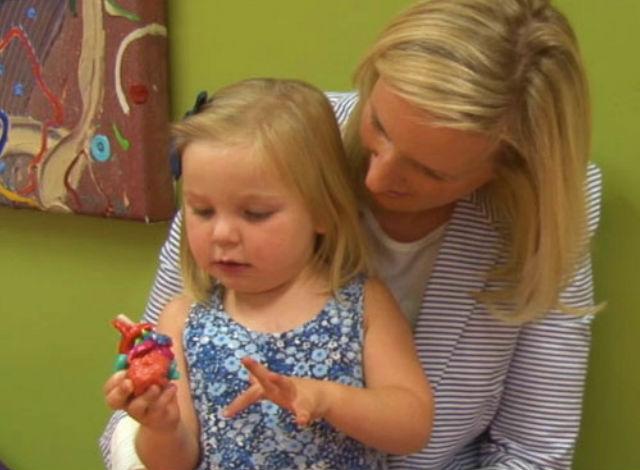Pioneers in 3D Printed Models: Toddler to Have Fourth Open-Heart Surgery at Phoenix Children’s Heart Center
The 3D printed model, while certainly a huge gift to many training for medical procedures, is of vast benefit and valuable on many levels. Made to be patient specific, these 3D models are made from MRI or CT data which is converted to a 3D printable file. And just those small unassuming plastic objects can often be the catalyst for changing or even saving a life, as well as allowing for a surgery that previously would not have even been possible.
The benefits of using the 3D model begin just as the patient’s journey does. It can be used to make a diagnosis and a treatment plan, and then serves as a visual aid to help explain to patients and their families what the condition involves and what will happen during the procedure. From there, if a new surgery is about to be performed, surgeons can use the 3D models as training tools, sometimes practicing on them for many, many hours as they work to perfect a procedure; after that, the models or guides are often brought into the operating room to help navigate the way, serving a range of purposes.
 For little Jemma Starks, a 3D printed model of her heart helps her gain some elementary understanding of what’s going on in her tiny two-year-old body, which has already withstood multiple surgeries due to a congenital heart defect discovered when she was just days old. But the 3D model does offer a higher purpose as well, of course, in that her doctor can use it to train for Jemma’s next procedure.
For little Jemma Starks, a 3D printed model of her heart helps her gain some elementary understanding of what’s going on in her tiny two-year-old body, which has already withstood multiple surgeries due to a congenital heart defect discovered when she was just days old. But the 3D model does offer a higher purpose as well, of course, in that her doctor can use it to train for Jemma’s next procedure.
According to Justin Ryan who is a researcher at Phoenix Children’s Heart Center Cardiac 3D Print Lab, the surgeon will put this model to extremely valuable use while doing his job, as well as sharing it with the patient and family.
“It also helps the family build confidence in their surgeon if they know they have already done the surgery on their patient before even touching the patient,” Ryan said.
Already, Jemma has learned to identify the chambers of the heart, thanks to the 3D printed model, which Ryan points out is not as new or ‘futuristic’ for the medical field as everyone might think. Thanks to the popularity of the technology now in the mainstream, 3D printing is receiving an enormous amount of attention.
“We are doing it right now. We have been doing it for years,” says Ryan, pointing out that the use of the technology has far surpassed fantasy and has been in use for nearly twenty years.
Phoenix Children’s was a pioneer in the use of 3D models in patient care, and has built quite a library, having produced over 300 models to the benefit of both patients and surgeons. They are used for surgical planning, family consultation, and are made in partnership with the Image Processing Applications Laboratory at Arizona State University.
In the meantime, while little Jemma is able to playfully hold a copy of her own heart in her hands, soon it will be used in navigating through her fourth surgery. She had the first when she was only eight days old, and her mother states that seeing the replicas helps them to understand what’s happening currently as well as what the future will hold for subsequent surgeries and treatment.
“For the first time we understood this fight,” Starks said. “And we are in a life-long fight against congenital heart disease.”
The cardiac lab has, according to their website, worked with 15 other institutions in six countries, and 3D cardiac models are often brought to the University for training medical students. They’ve also made 3D printed models for ears, the skeleton, blood vessels, the brain, and have used them to produce other 3D printed medical devices. While these model libraries are certainly not common, we have seen other institutions beginning to offer collections for valuable medical use, such as at Jump Trading Center, where they also hold an extensive 3D Printed Heart Library.
[Source / Images: Prescott eNews]
Subscribe to Our Email Newsletter
Stay up-to-date on all the latest news from the 3D printing industry and receive information and offers from third party vendors.
You May Also Like
3D Printing Unpeeled: New Arkema Material for HP, Saddle and Macro MEMS
A new Arkema material for MJF is said to reduce costs per part by up to 25% and have an 85% reusability ratio. HP 3D HR PA 12 S has been...
3D Printing News Briefs, January 20, 2024: FDM, LPBF, Underwater 3D Printer, Racing, & More
We’re starting off with a process certification in today’s 3D Printing News Briefs, and then moving on to research about solute trapping, laser powder bed fusion, and then moving on...
3D Printing Webinar and Event Roundup: December 3, 2023
We’ve got plenty of events and webinars coming up for you this week! Quickparts is having a Manufacturing Roadshow, America Makes is holding a Member Town Hall, Stratafest makes two...
Formnext 2023 Day Three: Slam Dunk
I’m high—high on trade show. I’ve met numerous new faces and reconnected with old friends, creating an absolutely wonderful atmosphere. The excitement is palpable over several emerging developments. The high...

































